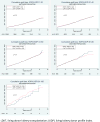A Risk Index for Living Donor Kidney Transplantation
- PMID: 26752290
- PMCID: PMC6114098
- DOI: 10.1111/ajt.13709
A Risk Index for Living Donor Kidney Transplantation
Erratum in
-
Erratum.Am J Transplant. 2020 Jan;20(1):324. doi: 10.1111/ajt.15727. Am J Transplant. 2020. PMID: 31894908 No abstract available.
Abstract
Choosing between multiple living kidney donors, or evaluating offers in kidney paired donation, can be challenging because no metric currently exists for living donor quality. Furthermore, some deceased donor (DD) kidneys can result in better outcomes than some living donor kidneys, yet there is no way to compare them on the same scale. To better inform clinical decision-making, we created a living kidney donor profile index (LKDPI) on the same scale as the DD KDPI, using Cox regression and adjusting for recipient characteristics. Donor age over 50 (hazard ratio [HR] per 10 years = 1.15 1.241.33 ), elevated BMI (HR per 10 units = 1.01 1.091.16 ), African-American race (HR = 1.15 1.251.37 ), cigarette use (HR = 1.09 1.161.23 ), as well as ABO incompatibility (HR = 1.03 1.271.58 ), HLA B (HR = 1.03 1.081.14 ) mismatches, and DR (HR = 1.04 1.091.15 ) mismatches were associated with greater risk of graft loss after living donor transplantation (all p < 0.05). Median (interquartile range) LKDPI score was 13 (1-27); 24.2% of donors had LKDPI < 0 (less risk than any DD kidney), and 4.4% of donors had LKDPI > 50 (more risk than the median DD kidney). The LKDPI is a useful tool for comparing living donor kidneys to each other and to deceased donor kidneys.
Keywords: clinical research/practice; graft survival; kidney transplantation/nephrology; kidney transplantation: living donor.
© Copyright 2016 The American Society of Transplantation and the American Society of Transplant Surgeons.
Conflict of interest statement
The authors of this manuscript have no conflicts of interest to disclose as described by the American Journal of Transplantation.
Figures



Comment in
-
Living Kidney Donor Profile Index: Utility and Limitations.Am J Transplant. 2016 Jul;16(7):1951-2. doi: 10.1111/ajt.13727. Epub 2016 Mar 3. Am J Transplant. 2016. PMID: 26805729 No abstract available.
References
-
- Wolfe RA, Ashby VB, Milford EL, Ojo AO, Ettenger RE, Agodoa LY, et al. Comparison of mortality in all patients on dialysis, patients on dialysis awaiting transplantation, and recipients of a first cadaveric transplant. N Engl J Med. 1999;341(23):1725–1730. - PubMed
-
- Held PJ, Kahan BD, Hunsicker LG, Liska D, Wolfe RA, Port FK, et al. The impact of HLA mismatches on the survival of first cadaveric kidney transplants. N Engl J Med. 1994;331(12):765–770. - PubMed
-
- Schold JD, Kaplan B, Baliga RS, Meier-Kriesche HU. The broad spectrum of quality in deceased donor kidneys. American journal of transplantation : official journal of the American Society of Transplantation and the American Society of Transplant Surgeons. 2005;5(4 Pt 1):757–765. - PubMed
-
- Ojo AO, Hanson JA, Meier-Kriesche H, Okechukwu CN, Wolfe RA, Leichtman AB, et al. Survival in recipients of marginal cadaveric donor kidneys compared with other recipients and wait-listed transplant candidates. J Am Soc Nephrol. 2001;12(3):589–597. - PubMed
-
- Port FK, Bragg-Gresham JL, Metzger RA, Dykstra DM, Gillespie BW, Young EW, et al. Donor characteristics associated with reduced graft survival: an approach to expanding the pool of kidney donors. Transplantation. 2002;74(9):1281–1286. - PubMed
Publication types
MeSH terms
Grants and funding
LinkOut - more resources
Full Text Sources
Other Literature Sources
Medical
Research Materials

